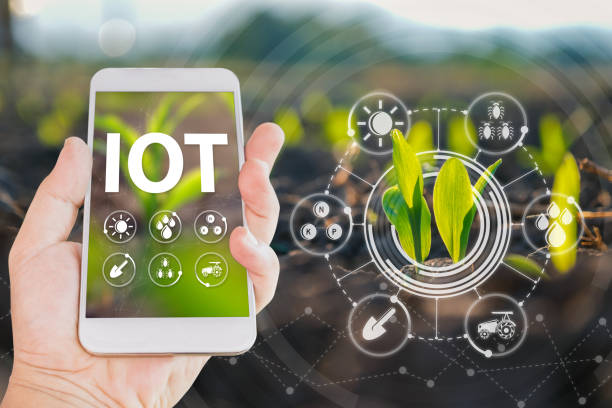
The agricultural industry has witnessed a profound transformation in recent years, thanks to the integration of Internet of Things (IoT) technologies.
IoT in agriculture, also known as smart farming, has revolutionised traditional farming practices, empowering farmers to make data-driven decisions, optimise resource utilisation, and enhance crop yields.
In this blog post, we’ll explore the fascinating world of IoT in agriculture and how it is reshaping farming practices to meet the challenges of a growing global population and sustainable agriculture.
Precision Agriculture: Enhancing Farming Efficiency with IoT Sensors

According to MDPI, Precision agriculture has emerged as a game-changer in the farming sector, driven by IoT sensors that collect and analyse real-time data from the fields.
These sensors measure crucial variables such as soil moisture, temperature, humidity, and nutrient levels, providing farmers with valuable insights into crop health and environmental conditions.
By accessing this data through IoT-enabled platforms, farmers can make informed decisions about irrigation schedules, optimal planting times, and the appropriate use of fertilisers and pesticides.
This data-driven approach not only maximises crop productivity but also minimises resource waste, making agriculture more sustainable and environmentally friendly.
Smart Irrigation: Water Conservation with IoT-based Solutions
Water scarcity is a growing concern in agriculture, and smart irrigation powered by IoT technology offers a solution.
IoT-based irrigation systems use data from sensors to calculate precise water requirements based on soil conditions, weather forecasts, and crop types.
These systems enable farmers to deliver the right amount of water directly to plant roots, reducing water usage and minimising water wastage through evaporation or runoff.
Additionally, remote monitoring and control capabilities of IoT irrigation systems empower farmers to manage irrigation schedules and detect leaks or malfunctions in real-time, ensuring optimal water usage and conservation.
Connected Livestock Monitoring: Improving Animal Health and Productivity
IoT in agriculture extends beyond crops to include livestock monitoring.
Advanced Technologies for Industries says connected sensors and wearable devices track the health and behaviour of animals, providing farmers with insights into their well-being and productivity.
For example, IoT-enabled collars or ear tags on cattle can monitor vital signs, detect signs of illness, and track feeding habits.
This data allows farmers to identify potential health issues early on, administer timely medical treatments, and optimise breeding and feeding practices for improved livestock productivity.
Automated Farm Equipment: Enhancing Efficiency and Labor Savings
The integration of IoT with farm equipment has led to the development of autonomous and connected machinery.
IoT-enabled tractors, drones, and harvesters can perform precise tasks, such as planting, spraying, and harvesting, with minimal human intervention.
Automation not only increases efficiency by reducing human error but also saves on labour costs and enhances productivity.
Furthermore, these machines can gather data while operating, allowing farmers to analyse and optimise farming practices further.
Crop Monitoring and Disease Detection: Early Intervention with IoT
Monitoring crops for signs of disease or pest infestation is vital for preventing yield losses.
ResearchGate cited that IoT in agriculture enables continuous monitoring of crops using sensors and image-recognition technology.
Smart cameras and sensors placed in fields can capture images of plants and analyse them for signs of stress, disease, or nutrient deficiencies.
By detecting issues early on, farmers can take immediate action, applying targeted treatments and minimising crop damage.
Supply Chain Optimization: Reducing Waste and Ensuring Quality
IoT technology plays a critical role in optimising the agricultural supply chain.
Connected sensors can track the condition of produce during transportation and storage, ensuring that the quality is maintained.
Farmers and distributors can use IoT data to make informed decisions about logistics, reducing transportation costs and minimising food waste.
Real-time tracking also helps identify potential bottlenecks in the supply chain, streamlining operations for improved efficiency.
Environmental Sustainability: Building a Resilient Future
One of the most significant impacts of IoT in agriculture is its contribution to environmental sustainability.
By optimising resource usage, reducing waste, and promoting precision agriculture, IoT-driven smart farming practices help build a resilient and sustainable future for agriculture.
Moreover, the data gathered through IoT sensors can contribute to a better understanding of the impact of climate change on agriculture.
This knowledge is crucial for developing adaptive strategies to protect crops and ensure food security in the face of changing environmental conditions.
Okay guys, now let’s look into some frequently asked questions (FAQs) about IoT in agriculture.
How does IoT improve farming practices in agriculture?
IoT in agriculture enhances farming practices by providing real-time data on soil conditions, crop health, weather patterns, and livestock monitoring.
This data-driven approach optimizes resource usage and increases productivity.
What are the benefits of using IoT in agriculture?
IoT benefits agriculture with increased efficiency, reduced resource wastage, precise irrigation, early pest detection, and improved crop yields.
It empowers farmers to make informed decisions for sustainable and profitable farming.
Can IoT help with sustainable agriculture?
Yes, IoT promotes sustainable agriculture by optimizing resource utilization, reducing environmental impact, and supporting precision farming techniques.
It enables a more eco-friendly and resilient agricultural ecosystem.
How can farmers adopt IoT in their farming practices?
Farmers can adopt IoT by integrating smart sensors, drones, and data analytics platforms into their operations.
Partnering with agricultural technology providers and leveraging government initiatives can also facilitate IoT implementation.
Conclusion
IoT in agriculture has opened up a new frontier of possibilities, transforming farming practices and driving innovation in the agricultural sector.
From precision agriculture to smart irrigation and connected livestock monitoring, IoT technologies are empowering farmers to make data-driven decisions that enhance productivity, conserve resources, and ensure environmental sustainability.
As the world faces the challenges of feeding a growing global population and addressing the impacts of climate change, IoT in agriculture offers a promising solution.
By embracing the potential of IoT and smart farming, we can cultivate a future where agriculture thrives, and food security is safeguarded for generations to come.








